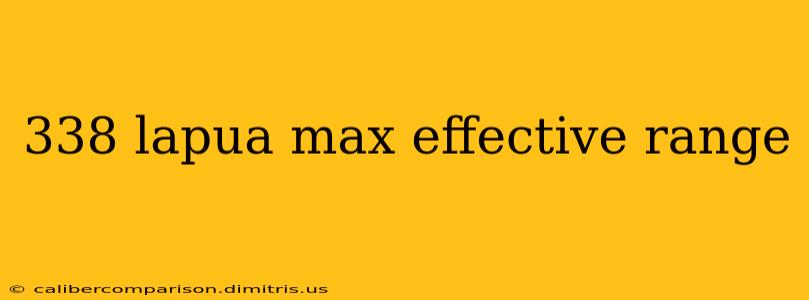The .338 Lapua Magnum is renowned for its extreme long-range capabilities, frequently favored by military snipers and precision long-range shooters. But what exactly constitutes its "maximum effective range"? The answer, unfortunately, isn't a single, easily defined number. It's a complex issue influenced by numerous factors. This article delves into the intricacies of .338 Lapua Magnum effective range, exploring the variables involved and providing a nuanced understanding of its performance limits.
Factors Affecting Effective Range
Several key factors influence the maximum effective range of the .338 Lapua Magnum:
1. Ballistics and Ammunition:
- Bullet Construction: Different bullet designs (match-grade, hunting, etc.) affect ballistic coefficient (BC), influencing downrange velocity and accuracy. Higher BC bullets retain velocity better over longer distances.
- Powder Charge: The amount of powder used directly impacts muzzle velocity, impacting the trajectory and effective range. Higher velocities generally translate to longer ranges but may increase recoil and barrel wear.
- Environmental Conditions: Wind speed and direction significantly affect bullet trajectory, especially at extended ranges. Temperature and air pressure also play a role, impacting bullet speed and trajectory.
2. Shooter Proficiency:
- Marksmanship Skills: Even the best cartridge is useless without a skilled shooter capable of precise aiming, trigger control, and wind compensation. Consistent accuracy is paramount at long ranges.
- Equipment: A high-quality rifle with a stable platform (bipod, tripod), a reliable optic with sufficient magnification, and appropriate spotting equipment are crucial for successful long-range shooting.
3. Target Characteristics:
- Target Size: The size and type of target significantly impact effective range. A larger target presents an easier shot at longer distances compared to a smaller one.
- Target Exposure: Concealment or cover provided by the target's environment can influence effective range, particularly by limiting sight lines or creating unpredictable bullet deflection.
Defining "Effective Range"
"Effective range" isn't simply the distance a bullet can travel. It's the distance at which a skilled shooter can consistently place shots within a lethal or acceptable area on the target, considering all environmental and equipment factors. For the .338 Lapua Magnum, this is often considered to be well beyond 1500 meters (approximately 1640 yards), but considerably less in less-than-ideal conditions. Claims of significantly greater ranges are possible with ideal conditions and extremely skilled shooters, but consistency becomes increasingly problematic.
Beyond the Numbers: Practical Considerations
While impressive numbers are often cited regarding the maximum range of the .338 Lapua Magnum, it's crucial to remember the practical limitations:
- Bullet Drop: At extreme ranges, bullet drop becomes significant, requiring precise adjustments using ballistic calculators and range finders.
- Wind Drift: Wind greatly impacts trajectory at longer distances, demanding proficient wind reading and compensation skills.
- Environmental Factors: Temperature variations, air pressure changes, and humidity fluctuations all affect the flight of the bullet and need careful consideration.
Conclusion: It's About More Than Just Distance
The .338 Lapua Magnum's effective range isn't a single figure. It's a complex interplay of ballistic factors, shooter skill, environmental conditions, and target characteristics. While it's capable of extreme accuracy at remarkable distances, practical application requires a thorough understanding of these variables for consistent and effective long-range shooting. Focusing on proficiency, equipment, and environmental awareness will yield far more consistent and successful long-range shooting than simply chasing the maximum theoretical range.

